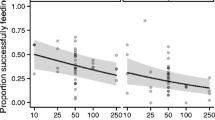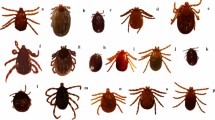Abstract
The brown dog tick, Rhipicephalus sanguineus, is the most widespread tick in the world and infests primarily domestic dogs. Studies on the bio-ecology of R. sanguineus have been carried out worldwide, but little is known of the on-dog relationships of tick developmental stages and their possible role on tick feeding performance, reproduction and pathogen transmission. We studied the relationships between different developmental stages of R. sanguineus on particular body areas of naturally infested dogs. In addition, we assessed whether these relationships could vary according to sex and breed of the dogs. Over 2,200 tick records were analyzed and the results showed that attachment sites of males and females are strongly positively correlated whereas attachment sites of nymphs and adults tend to be negatively correlated. Our findings indicate that adult ticks generally feed on sites (e.g., ears) that make it difficult for dogs to remove them, whereas immatures feed on lower areas of the dog’s body (e.g., belly, rump, and hind legs), probably because of their more limited mobility. Further research on the possible on-dog interactions of adult and immature ticks is needed to better understand why their attachment sites tend to be negatively correlated and to assess their possible implications for pathogen transmission.




Similar content being viewed by others
References
Cruz-Vazquez C, Garcia-Vazquez Z (1999) Seasonal distribution of Rhipicephalus sanguineus ticks (Acari: Ixodidae) on dogs in an urban area of Morelos, Mexico. Exp Appl Acarol 23:277–280
Dantas-Torres F (2008) The brown dog tick, Rhipicephalus sanguineus (Latreille, 1806) (Acari: Ixodidae): from taxonomy to control. Vet Parasitol 152:173–185
Dantas-Torres F (2010) Biology and ecology of the brown dog tick, Rhipicephalus sanguineus. Parasit Vectors 3:26
Dantas-Torres F, Melo MF, Figueredo LA, Brandão-Filho SP (2009) Ectoparasite infestation on rural dogs in the municipality of São Vicente Férrer, Pernambuco, Northeastern Brazil. Rev Bras Parasitol Vet 18:75–77
Koch HG (1982) Seasonal incidence and attachment sites of ticks (Acari: Ixodidae) on domestic dogs in southeastern Oklahoma and northwestern Arkansas, USA. J Med Entomol 19:293–298
Lorusso V, Dantas-Torres F, Lia RP, Tarallo VD, Mencke N, Capelli G, Otranto D (2010) Seasonal dynamics of the brown dog tick (Rhipicephalus sanguineus) on a confined dog population in Italy. Med Vet Entomol 24:309–315
Louly CCB, Fonseca IN, Oliveira VF, Linhares GFC, Menezes LB, Borges LMF (2007) Seasonal dynamics of Rhipicephalus sanguineus (Acari: Ixodidae) in dogs from a police unit in Goiânia, Goiás, Brazil. Cienc Rural 37:464–469
Louly CCB, Soares S, Silveira D, Neto O, Silva A, Borges L (2009) Differences in the susceptibility of two breeds of dogs, English cocker spaniel and beagle, to Rhipicephalus sanguineus (Acari: Ixodidae). Int J Acarology 35:25–32
Nuttall GHF (1915) Observations on the biology of Ixodidae. Parasitology 7:408–456
Otranto D, Lia RP, Cantacessi C, Galli G, Paradies P, Mallia E, Capelli G (2005) Efficacy of a combination of imidacloprid 10%/permethrin 50% versus fipronil 10%/(s)-methoprene 12%, against ticks in naturally infected dogs. Vet Parasitol 130:293–304
Otranto D, Dantas-Torres F, Breitschwerdt EB (2009) Managing canine vector-borne diseases of zoonotic concern: part two. Trends Parasitol 25:228–235
Otranto D, de Caprariis D, Lia RP, Tarallo V, Lorusso V, Testini G, Dantas-Torres F, Latrofa S, Diniz PPVP, Mencke N, Maggi RG, Breitschwerdt E, Capelli G, Stanneck D (2010) Prevention of endemic canine vector-borne diseases using imidacloprid 10% and permethrin 50% in young dogs: a longitudinal field study. Vet Parasitol 172:323–332
Rechav Y, Nuttall PA (2000) The effect of male ticks on the feeding performance of immature stages of Rhipicephalus sanguineus and Amblyomma americanum (Acari: Ixodidae). Exp Appl Acarol 24:569–578
Tinoco-Gracia L, Quiroz-Romero H, Quintero-Martínez MT, Rentería-Evangelista TB, González-Medina Y, Barreras-Serrano A, Hori-Oshima S, Moro MH, Vinasco J (2009) Prevalence of Rhipicephalus sanguineus ticks on dogs in a region on the Mexico-USA border. Vet Rec 164:59–61
Walker JB, Keirans JE, Horak IG (2000) The genus Rhipicephalus (Acari, Ixodidae): a guide to the brown ticks of the world. Cambridge University Press, Cambridge
Acknowledgments
This work was partially supported by the Fondazione Cassa di Risparmio di Puglia. Thanks to Viviana D. Tarallo, Luciana A. Figueredo, Vicenzo Lorusso and Riccardo P. Lia for their help during tick collections.
Author information
Authors and Affiliations
Corresponding author
Rights and permissions
About this article
Cite this article
Dantas-Torres, F., Otranto, D. Rhipicephalus sanguineus on dogs: relationships between attachment sites and tick developmental stages. Exp Appl Acarol 53, 389–397 (2011). https://doi.org/10.1007/s10493-010-9406-4
Received:
Accepted:
Published:
Issue Date:
DOI: https://doi.org/10.1007/s10493-010-9406-4




